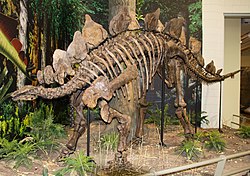Timeline of stegosaur research
[1] However, they would not be recognized as a distinct group of dinosaurs until Othniel Charles Marsh described the new genus and species Stegosaurus armatus in 1877, which he regarded as the founding member of the Stegosauria.
Nearly forty years later, Davitashvili argued that the plates were too fragile to be used for defense and instead used to attract mates and signal the stegosaur's rank in a social hierarchy.
[3] In the late 1970s, James O. Farlow and others would propose that the thin, blood vessel-rich plates helped absorb or lose body heat, depending on the animal's own physiological requirements.
[4] This hypothesis was put forth in a broader context of scientists considering the possibility that dinosaurs may have maintained body temperatures and activity levels similar to those of modern birds and mammals,[5] in which case the plates may have served primarily to shed heat rather than gain it.
In the late 1980s Buffrenil and others revived the idea that stegosaur plates were display structures, an interpretation that would continue to find favor from researchers like Main and colleagues into the 21st century.

























